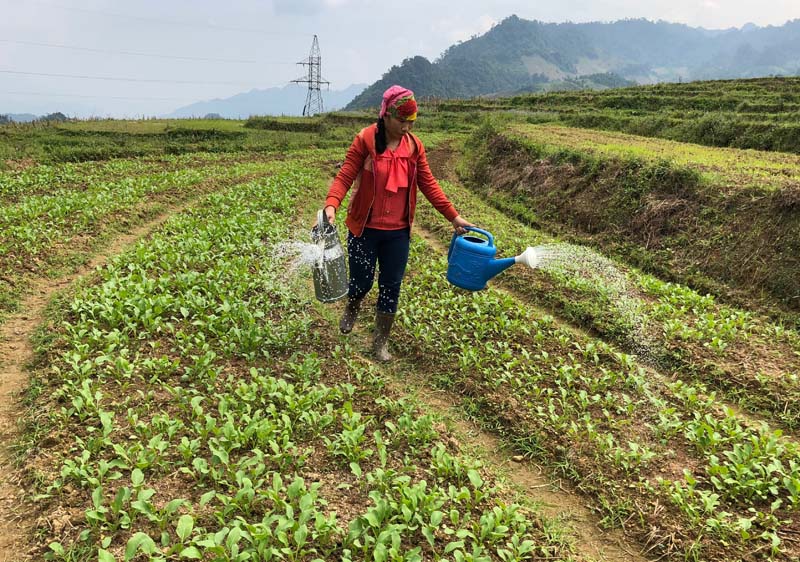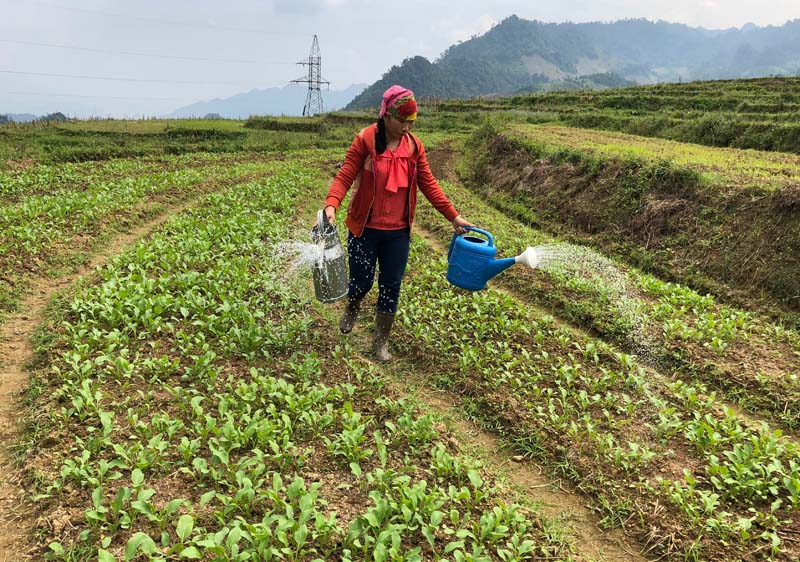
(HBO) - In recent years, mountainous communes of Mai Chau district have actively expanded vegetable cultivation areas. Approximately 80 percent of vegetable output of the district is provided for Hanoi, Hung Yen, Hai Duong, Quang Ninh, and Hai Phong.
In order to increase the supply chain of safe food in
general and safe vegetables in particular to protect consumers’ health, the agro-forestry-fishery
product quality management sub-department
selected Tan Son commune of Mai Chau district to build a safe vegetable production
and consumption model applying Vietnamese Good Agricultural Practices (VietGAP).

Member
households of the Tam Hoa Cooperative applythe VietGAP production process
in vegetable cultivation.
Carried out since July 2018, the model is joined by
the Tam Hoa agricultural service and development cooperative and ten vegetable-farming
households. In order to effectively implement the model, many measures have
been taken to upgrade and improve infrastructure facilities to meet VietGAP
requirements for vegetable cultivation. A training course was organised for 20
local residents both members and non-members of the cooperative.
In order to ensure the efficient and sustainable
development of the Tam Hoa agricultural service and development cooperative,
the sub-department has supported the establishment of the VietGAP board to coordinate
with the cooperative in developing a quality management system, which focuses
on quality policy and objective, techniques for chayote, choysum, cabbage,
spinach, and pumpkin farming.
The system also includes regulations on management and
use of seeds, cultivation land, fertilizers, plant protection products; harvesting
and processing; and handling violations in meeting VietGAP requirements.
The cooperative has signed contracts and memoranda of understandingfor supplying safe
vegetable products with a number of safe
vegetable trading establishments
in Hanoi, Bac Ninh and Hung yen provinces./.
According to data from the Hoa Binh Provincial Party Committee, the industrial production index for the first six months of 2025 is estimated to have increased by 20% compared to the same period last year. This marks the highest year-on-year growth rate for this period since 2020.
In the first six months of 2025, Hoa Binh province’s export turnover was estimated at 1.145 billion USD, marking an 18.11% increase compared to the same period in 2024. Import turnover was estimated at $ 804 million, a 17.15% increase, which helped the province maintain a positive trade balance.
The lives of the ethnic minority farmers in Tan Lac district have gradually improved thanks to the new directions in agricultural production. This is a testament to the collective strength fostered through the professional associations and groups implemented by various levels of the district’s Farmers’ Union.
With the motto the "product quality comes first,” after nearly one year of establishment and operation, Muong village’s Clean Food Agricultural and Commercial Cooperative, located in Cau Hamlet, Hung Son Commune (Kim Boi district), has launched reputable, high-quality agricultural products to the market that are well-received by consumers. The products such as Muong village’s pork sausage, salt-cured chicken, and salt-cured pork hocks have gradually carved out a place in the market and they are on the path to obtaining the OCOP certification.
In the past, the phrase "bumper harvest, rock-bottom prices" was a familiar refrain for Vietnamese farmers engaged in fragmented, small-scale agriculture. But today, a new spirit is emerging across rural areas of Hoa Binh province - one of collaboration, organisation, and collective economic models that provide a stable foundation for production.
Maintaining growing area codes and packing facility codes in accordance with regulations is a mandatory requirement for agricultural products to be eligible for export. Recently, the Department of Agriculture and Environment of Hoa Binh province has intensified technical supervision of designated farming areas and packing facilities to safeguard the "green passport" that enables its products to access international markets.



